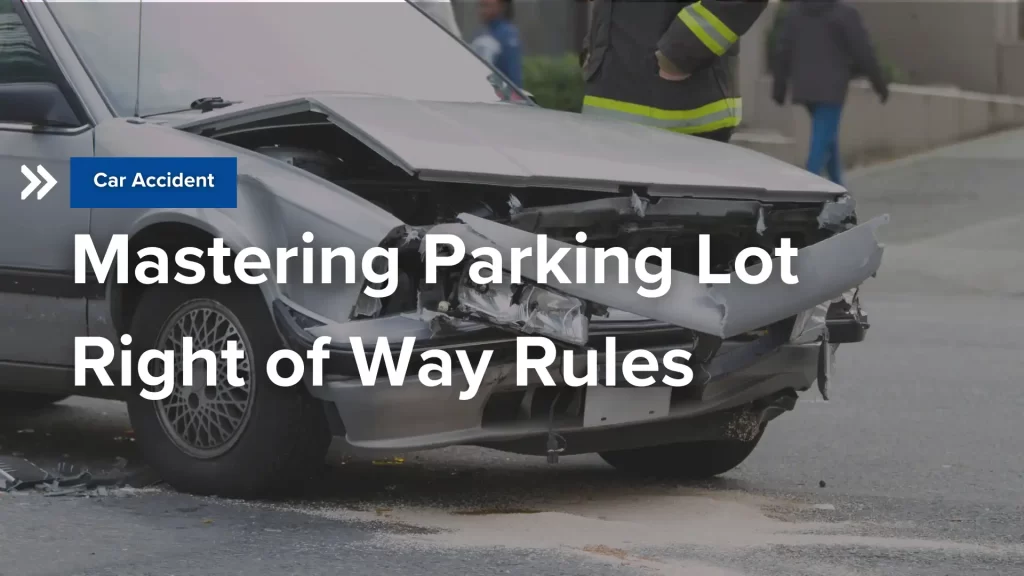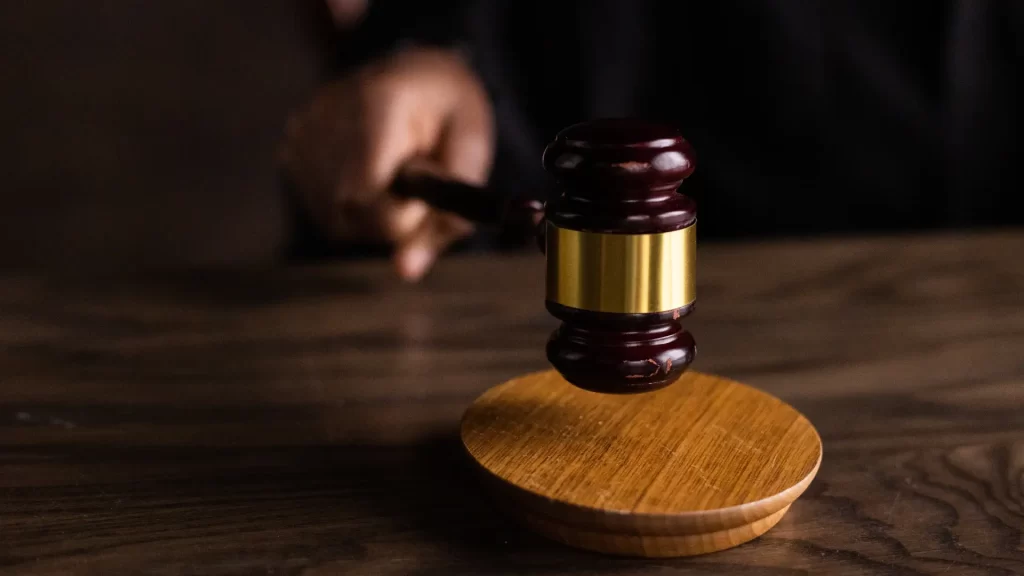
Confused about who yields to whom in a parking lot? You’re not alone. The parking lot right-of-way rules are essential for every driver to understand to prevent accidents and facilitate smooth traffic flow. It’s not just about courtesy; it’s about safety and legal responsibility. This article cuts through the confusion to give you a clear understanding of these rules, preparing you to handle every turn and stop with confidence.
Understanding Right of Way in Parking Lots
What parking lot right-of-way rules apply in Chicago, Illinois? Understanding the hierarchy of Illinois right-of-way laws is key when driving through a parking lot. Vehicles in thoroughfare lanes, which are the primary lanes running through the parking lot, have the right-of-way over all other vehicles, including those in feeder lanes and parked vehicles. This ensures a smooth and organized flow of traffic.
Vehicles in feeder lanes, which connect parking spaces to the thoroughfare lane, are required to yield to vehicles in the thoroughfare lanes. This practice promotes a safe and orderly traffic flow within the parking area. Regarding parked vehicles, on the other hand, drivers must yield to both moving traffic in the feeder lane and thoroughfare lanes to prevent parking lot accidents.
In situations where two vehicles approach each other, the general rule is that the vehicle on the right has the right-of-way, meaning the driver on the left should yield. This rule helps in avoiding confusion and potential collisions. Moreover, a backing driver is typically considered at fault if they collide with a moving vehicle that has the right of way unless the other driver is speeding or distracted.
Comprehension of these right-of-way rules of the road can greatly mitigate the risk of car accidents in parking lots.
Pedestrian Priority: The Unwritten Rule of Parking Lots
Pedestrians always take precedence in parking lots. Drivers are required to yield to pedestrians at all times, even if they are not using designated crosswalks. Local laws often implement safety measures in busy parking lots, such as barriers and bollards, to protect pedestrian zones and prevent vehicles from entering these areas. These safety devices must comply with local building codes and the Americans with Disabilities Act, ensuring they are effective in safeguarding pedestrians.
Hence, remain vigilant when crossing pedestrians and be ready to stop, irrespective of their location within or outside marked crosswalks.
Decoding Traffic Signs and Pavement Markings
Traffic signs and pavement markings in parking lots are not merely suggestions; they are critical for maintaining order and safety. Stop signs and yield signs are strategically placed to manage the traffic flow and minimize the risk of accidents. Drivers must obey these signs without exception. Failing to stop at a stop sign or yield when required can lead to severe consequences, including collisions and injuries.
Additionally, pavement markings such as arrows indicating lane directions, crosswalks, and no-parking zones play an essential role in guiding drivers and ensuring pedestrian safety. Observing these markings helps maintain a smooth traffic flow and prevents confusion among drivers.
A heightened awareness of traffic signs and pavement markings can greatly diminish the likelihood of parking lot car accidents.
The Etiquette of Exiting Parking Spaces
Parking lot right-of-way rules often involve a certain unspoken and unwritten etiquette. Exiting a parking space safely is an art that requires patience and vigilance. Drivers should always be on high alert, using their turn signals to communicate their intentions to other drivers. Before backing out, ensure your vehicle is visible to other drivers and pedestrians, especially in a busy parking lot. Yielding to approaching vehicles and pedestrians is crucial to prevent parking lot accidents.
When merging into the main traffic flow from a parking space, timing is everything. Patience is key in waiting for the optimal moment to merge without hindering other vehicles. Adhering to these etiquette rules can bolster driver confidence and minimize accidents when exiting parking spots.
The Challenge of Limited Visibility
Limited visibility is a common challenge when exiting a parking space, often due to other parked cars obstructing the view. To navigate this safely, drivers should carefully check mirrors and rear windows before pulling out. Positioning the vehicle for optimal visibility can also help in spotting any oncoming traffic or pedestrians.
Careful navigation around obstacles and ensuring a clear path before exiting is paramount. When visibility is poor, taking extra time to check all angles can prevent collisions and ensure a safe exit from the parking space.
Collision Conundrums: Who’s at Fault?
Determining fault in parking lot accidents can be complex, particularly when both drivers are backing out simultaneously. In such cases, the fault is often shared between the two drivers because both have a duty to be aware of their surroundings.
Parking lot accidents are surprisingly common. Discerning fault in these scenarios is pivotal for processing insurance claims and potential legal proceedings.
Both drivers must be vigilant and exercise caution to avoid these situations, but when accidents do happen, knowing the rules can help in resolving the issue fairly.
Exchange Information and Document Everything
After a parking lot accident, the first step is to exchange insurance and contact information with the other driver. This ensures that both parties have the necessary details to file insurance claims. Documenting the scene with photos and videos is also crucial as it provides evidence of the vehicle damage and the positions of the cars involved.
If there are witnesses, obtaining their contact information can be invaluable for supporting your case. Additionally, seeking immediate medical attention is important, as some injuries might not be immediately apparent. Proper documentation and medical reports can strengthen any legal claims or insurance disputes that arise from the accident.
The Strategy of Reverse Parking
Reverse parking is a strategy that significantly reduces the risk of accidents in parking lots. By backing into a parking space, drivers can avoid the need to back out into oncoming traffic, which is often fraught with blind spots and poor visibility. This method allows for a clearer view of pedestrians and other vehicles when exiting the parking space, thereby enhancing safety.
Moreover, reverse parking offers several benefits:
- It makes it easier to yield to pedestrians and other vehicles upon departure
- It lessens the odds of parking lot car accidents
- It facilitates a smoother exit from the parking spot
When Accidents Escalate: Seeking Legal Help
 Parking lot right-of-way rules sometimes are unhelpful in accidents that are caused by negligence and/or ignorance. In the event of parking lot accidents escalating into major incidents with substantial property damage or personal injury, it becomes imperative to seek legal assistance. Car accident attorneys are equipped to handle the complexities of legal procedures and collect the necessary evidence to pursue adequate compensation. They possess the negotiation skills needed to deal with insurance companies and ensure that victims receive fair settlements. Some reasons to seek legal assistance in parking lot accidents include:
Parking lot right-of-way rules sometimes are unhelpful in accidents that are caused by negligence and/or ignorance. In the event of parking lot accidents escalating into major incidents with substantial property damage or personal injury, it becomes imperative to seek legal assistance. Car accident attorneys are equipped to handle the complexities of legal procedures and collect the necessary evidence to pursue adequate compensation. They possess the negotiation skills needed to deal with insurance companies and ensure that victims receive fair settlements. Some reasons to seek legal assistance in parking lot accidents include:
- Substantial property damage
- Personal injury
- Complex legal procedures
- Collecting necessary evidence
- Pursuing adequate compensation
- Dealing with insurance companies
- Ensuring fair settlements
Without legal representation, individuals may risk accepting lowball offers from an insurance company, not fully understanding their rights to compensation for medical bills, lost wages, and future medical expenses. Hence, a consultation with a car accident attorney can markedly influence the outcome of your case and build your case with precedents that support your claims.
Adjusting to Local Laws and Lot-Specific Rules
Acquainting oneself with local laws and parking lot-specific rules is pivotal for maintaining safety and averting accidents. Speed limits in parking lots are generally set lower, typically at 10-15 miles per hour, to protect all users. Adhering to these speed limits and understanding the general rules can help maintain a safe environment for everyone.
Additionally, some parking lots may have specific rules regarding the direction of traffic, designated pedestrian zones, and parking restrictions. Being aware of these rules and following them diligently can prevent parking lot accidents and ensure a smoother traffic flow.
Frequently Asked Questions
What should drivers do if they are involved in a parking lot accident?
If you are involved in a parking lot accident, be sure to exchange insurance information, document the scene, and seek medical attention if necessary. It is important to take these steps to ensure proper handling of the situation.
How can reverse parking reduce the risk of accidents?
Reverse parking can reduce the risk of accidents by improving visibility when exiting a parking space, allowing for easier yielding to pedestrians and other vehicles.
What are the speed limits in parking lots?
In parking lots, the speed limits are typically set at 10-15 miles per hour in order to prioritize safety for everyone.
Why is it important to obey traffic signs and pavement markings in parking lots?
It is important to obey traffic signs and pavement markings in parking lots to maintain order, manage traffic flow, and prevent accidents.
How can legal help be sought after a serious parking lot accident?
You should contact a car accident lawyer in Chicago at 312-200-2000 for legal assistance and case reviews.
Contact a Chicago Car Accident Lawyer
What parking lot right-of-way rules apply in Chicago? Mastering the right-of-way rules in parking lots is essential for preventing accidents and ensuring a safe environment. At JJ Legal, our Chicago car accident attorneys can help you understand the hierarchy of thoroughfare lanes, feeder lanes, and pedestrian priority so drivers can move through parking lots more confidently and safely. Obeying traffic signs and pavement markings, practicing safe exiting techniques, and adopting reverse parking can further reduce the risk of collisions.
When accidents do occur, knowing how to determine fault, exchange information, and document the scene can make a significant difference in resolving the issue. Seeking legal help from our team can ensure proper handling of legal procedures and fair compensation. Call us at 312-200-2000 for a free case review of local laws and parking lot-specific rules.



